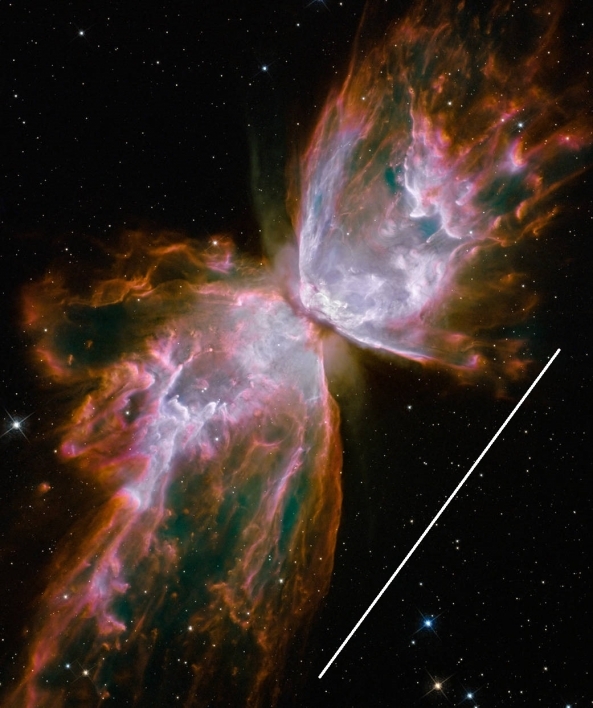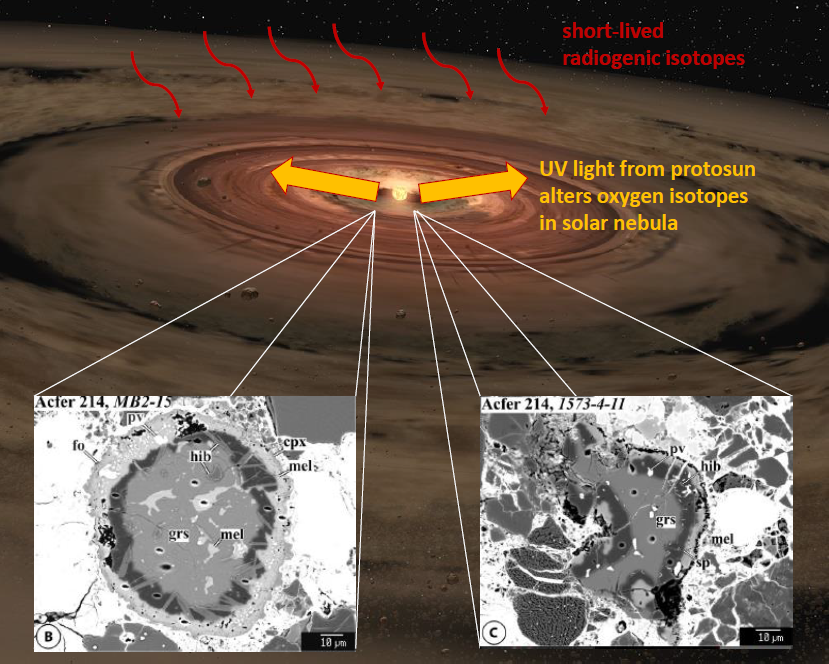Ultraviolet shines light on origins of the solar system

The Butterfly nebula, an example of a star-forming region. A bright central star, obscured by dust, modifies the oxygen isotopes in the nebula by photodissociation of carbon monoxide. This is an example of an environment in which oxygen isotopes could be modified in the molecular cloud prior to formation of a planetary system. Credit: NASA and ESA
In the search to discover the origins of our solar system, an international team of researchers, including planetary scientist and cosmochemist James Lyons of Arizona State University, has compared the composition of the sun to the composition of the most ancient materials that formed in our solar system: refractory inclusions in unmetamorphosed meteorites.
By analyzing the oxygen isotopes (varieties of an element that have some extra neutrons) of these refractory inclusions, the research team has determined that the differences in composition between the sun, planets and other solar system materials were inherited from the protosolar molecular cloud that existed even before the solar system. The results of their study have been recently published in Science Advances.
“It has been recently demonstrated that variations in isotopic compositions of many elements in our solar system were inherited from the protosolar molecular cloud,” said lead author Alexander Krot, of the University of Hawaii. “Our study reveals that oxygen is not the exception.”
Molecular cloud or solar nebula?
When scientists compare oxygen isotopes 16, 17 and 18, they observe significant differences between the Earth and the sun. This is believed to be due to processing by ultraviolet light of carbon monoxide, which is broken apart leading to a large change in oxygen isotope ratios in water. The planets are formed from dust that inherits the changed oxygen isotope ratios through interactions with water.
What scientists have not known is whether the ultraviolet processing occurred in the parent molecular cloud that collapsed to form the proto-solar system or later in the cloud of gas and dust from which the planets formed, called the solar nebula.
A star-forming region in NGC 3324 in the Carina nebula. Neighboring large stars both sculpt the shape of the nebula and alter the distribution of oxygen isotopes by the photodissociation of carbon monoxide by ultraviolet light. The results of the work presented here favor alteration of oxygen isotopes in a molecular cloud environment (white scale bar is 5 light years or 300,000 AU). Image credit: NASA, ESA, Hubble Heritage Team
To determine this, the research team turned to the most ancient component of meteorites, called calcium-aluminum inclusions (CAIs). They used an ion microprobe, electron backscatter images and X-ray elemental analyses at the University of Hawaii’s Institute of Geophysics and Planetology to carefully analyze the CAIs. They then incorporated a second isotope system (aluminum and magnesium isotopes) to constrain the age of the CAIs, making the connection — for the first time — between oxygen isotope abundances and mass 26 aluminum isotopes.
From these aluminum and magnesium isotopes, they concluded that the CAIs were formed about 10,000 to 20,000 years after the collapse of the parent molecular cloud.
“This is extremely early in the history of the solar system,” said Lyons, who is an associate research professor at ASU’s School of Earth and Space Exploration, “so early that there would not be enough time to alter oxygen isotopes in the solar nebula.”
Although more measurements and modeling work are needed to fully assess the implications of these findings, they do have implications for the inventory of organic compounds available during solar system and later planet and asteroid formation.
“Any constraint on the amount of ultraviolet processing of material in the solar nebula or parent molecular cloud is essential for understanding the inventory of organic compounds that lead to life on Earth,” Lyons said.
More Science and technology

Applied Materials invests in ASU to advance technology for a brighter future
For nearly 60 years, global giant Applied Materials has been hard at work engineering technology that continues to change how…

Meet ASU engineering students who are improving health care, computing and more
Furthering knowledge of water resource management, increasing the efficiency of manufacturing point-of-care health diagnostic…

Turning up the light: Plants, semiconductors and fuel production
What can plants and semiconductors teach us about fuel production?ASU's Gary Moore hopes to find out.With the aim of learning how…




